DUBREUILVILLE, ONTARIO — Alamos Gold (TSX: AGI; NYSE: AGI) has extended gold mineralization along strike and down-plunge from existing reserves and resources at its newly acquired and producing Island Gold underground mine, 83 km northeast of Wawa, Ont., and just outside the town of Dubreuilville.
The results come from Alamos’ 2018 exploration program, which is targeting three areas at Island Gold: the deposit’s main, eastern and western extensions. In the main and western extensions, Alamos is testing east-plunging shoots below existing reserves and resources. In the eastern extension it’s exploring plunging shoots along strike beyond existing reserves and resources.
The company says results from infill drilling confirm the mineralization’s continuity.
Highlights from the program include 14.18 grams gold per tonne (32.06 grams uncut) over 4 metres from 1,529 metres downhole in the main extension; 42.14 grams gold (71.27 grams uncut) over 5 metres from 84 metres downhole in the eastern extension; and 31.54 grams gold over 5 metres from 1,363 metres downhole in the western extension.
With the positive results, Alamos has boosted its 2018 exploration budget for Island Gold from $15 million to $18 million, and added two more surface drill rigs — bringing its total to six. The added rigs will increase Alamos’ surface directional drilling from 33,000 metres to 45,000 metres.
“Our budget is conservative — we should be able to achieve it, if not beat it,” Alamos chief financial officer Jamie Porter says in a presentation during a site visit to Island Gold that The Northern Miner attended in late May.
The program includes 30,000 metres of underground exploration drilling, 35,000 metres of underground delineation drilling and 15,000 metres of regional exploration that will test targets along the Goudreau deformation zone, west of the main Island Gold deposit, and try to extend gold mineralization structures intercepted in 2016 below the Kremzar gold deposit, 2 km north of the project.
So far this year the company has drilled 33,800 metres across 115 holes: 13,850 metres of surface exploration drilling, 12,550 metres of underground exploration drilling and 7,400 metres of underground delineation drilling.
Alamos mainly conducts underground delineation drilling from its 620 and 840 underground levels, aiming to convert inferred resources into indicated resources.
After the presentation, we head underground in white trucks moving no faster than 15 km an hour to the project’s 800 east level. The journey takes 25 minutes. Here at the face, miners sampled 23.11 grams gold over 4.2 metres wide and 140 metres long.

Jeremy Poon, associate with Raymond James, examines a piece of ore underground at Island Gold. Photo by Richard Quarisa.

Alamos Staff indicate points of interest on a the face of a tunnel more than 800 metres underground at the Island Gold mine. Photo by Richard Quarisa.
We descend another two minutes to the 860 level. Alamos’ priority is to keep pushing down. It will start mining at the 860 level before heading back up to 800. The face at the end of the tunnel was sampled the day before we arrived, and set for blasting later that night.
Alamos picked up Island Gold in late 2017 when it acquired the project’s owner, Richmont Mines, in a friendly takeover valued at US$770 million. Alamos announced the deal on Sept. 11, 2018. The week prior, Alamos shares traded above $10 per share. After the announcement, its share price slumped 16% to $8.60.
In the following months, shares of Alamos continued a slow but steady decline, closing as low as $6.30 in late February 2018.
“I wasn’t surprised at all,” Alamos president and CEO John McCluskey says in an interview with The Northern Miner. “In fact, I anticipated the settle would be exactly what it was.”
He attributes the market reaction to the lack of coverage Richmont received before the acquisition. He says the modest amount of coverage Richmont did receive focused on the company’s preliminary economic assessment (PEA) in mid-2017. He says any reference to the project’s geological potential acknowledged its existence, but didn’t define it clearly.

A mill at Alamos Gold’s Island Gold gold mine near Wawa, Ontario. Photo by Richard Quarisa.
“We were able to do what a typical investor can’t do, and in fact what the company was not really at liberty to disclose,” McCluskey says. “We were able to look at it and take our own view on it. And if we can’t do that, then effectively we’re no better than a bank analyst or an investor who isn’t fully engaged with mining exploration and operations.
“We got access to all the raw data and we were able to model it ourselves, in-house. By going through that exercise we were able to come to a clearer view of where that orebody was going and just how high quality the resources were. We don’t have the reputation of going in and overpaying for anything.”
Island Gold began production as a joint venture between Richmont Mines and Patricia Mining in 2007. One year later, Richmont acquired Patricia, along with a 100% interest in Island Gold. The company tabled an initial expansion PEA in 2015, and a second in 2017 that suggested an increase to 1,100 tonnes per day.
“If you took away the inferred, it would have been a prefeasibility- to feasibility-level study,” Alamos’ chief mine engineer Leon LeBlanc says.
Alamos acquired Richmont in November 2017. By year’s end, reserves at Island Gold increased 18% to 887,000 oz. gold. The grade increased 11% to 10.2 grams gold.

Alamos Staff lead a tour through the Island Gold core shack. Photo by Richard Quarisa.

Visible gold circled in red on display in the Island Gold core shack. Photo by Richard Quarisa.
Production at the Island Gold mine has risen steadily since 2013, when it produced 34,000 oz. gold. The next year it produced 42,000 oz. gold and the year after, 55,000 oz. gold, before jumping to 83,000 oz. gold in 2016.
In 2017, Island Gold produced a record 99,000 oz. gold. Alamos says it could top that in 2018 with up to 105,000 oz. gold.
All-in sustaining costs at Island Gold have fallen with the mine’s rising production. In 2013, the mine produced at US$1,452 per oz. gold. Costs fell as low as US$599 per oz. gold in 2017, but will likely rise to US$825 this year.
Alamos attributes the trend to improved grade. In 2014, reserves at Island Gold graded 6.4 grams gold. By 2016, the grade had improved to 9.2 grams gold.
The project now has 2.7 million proven and probable tonnes grading 10.2 grams gold for 887,000 oz. gold.
It also has 591,000 measured and indicated tonnes grading 5.86 grams gold for 111,000 oz. gold, and 2.9 million inferred tonnes grading 9.55 grams gold for 908,000 oz. gold.
The project boasts a 383% increase in reserves and a 60% increase in reserve grade since 2014. Its reserve life grew to seven years with the company’s 2017 year-end update.
Another 236,000 oz. gold in reserves more than offset the depleted 102,000 oz. gold, and Alamos says it expects to expand mine life with more exploration. Over the past five years, the project has averaged $21 per oz. gold in discovery costs.
“Sometimes when the [geologists] look at things, it’s like: ‘Geez, guys, we’re not sure this thing is going to hang together,’” Alamos chief operating officer Peter MacPhail says. “But when we came to look at Island Gold in July we were pretty impressed. In this case it was like: ‘This thing hangs together, and maybe is even better than we think.’”
Richmont’s 2017 PEA aimed to determine the best way to mine four horizons up to a maximum depth of 1,000 metres using the current mine infrastructure. Part of it suggested expanding to a 1,100-tonne-per-day operation.
The mill at Island Gold operates at 900 tonnes per day, but its permit allows 1,100 tonnes per day. During the site visit, we drive to it in a bus branded “Richmont.”
Alamos says it’s on track to complete the mill expansion — which will include capacity for up to 1,200 tonnes per day — by the end of September.
The upgraded facility will include a new ball mill, maintenance shop and reagent bay. Its footprint will double.
Alamos will shut down the mill for seven days during construction, but says it can make up the lost tonnage with higher capacity.
It predicts it will process 1,000 tonnes per day for the year.

Alamos staff are working to double the footprint of the current mill. Photo by Richard Quarisa.

The tailings pond at Island Gold, which Alamos may expand in the next few years. Photo by Richard Quarisa.
The company is also upgrading its mining fleet to support 1,100 tonnes per day of production. It’s phasing in higher-capacity, 42-tonne trucks from its current 30-tonne trucks, and adding two scoops and one boom truck.
“The effort is already underway to increase the permitting capacity of the mill so we can process 1,200 tonnes per day,” McCluskey says.
Alamos produced 28,100 oz. gold in the first quarter of 2018. It expects the mill expansion will drive production higher in the fourth quarter, putting the company on pace for its 2018 target of 95,000 to 105,000 oz. gold.
The company had US$553 per oz. gold total cash costs, compared to US$575 per oz. gold for the year, and estimates spending $130 per tonne of underground mining for 2018 — although it expects this cost will stabilize moving forward.
“It’s interesting looking at the context of this acquisition because picking up Island Gold pushed us up over 500,000 oz. annualized production,” McCluskey says.
Including Island Gold, Alamos has four producing mines. The Young-Davidson underground gold mine sits near the town of Matachewan, 60 km west of Kirkland Lake. It’s part of the same mining district as Island Gold, which includes McEwen Mining’s (TSX: MUX; NYSE: MUX) Black Fox gold mine and Tahoe Resources’ (TSX: THO; NYSE: TAHO) Timmins West gold mine. In 2017, Young-Davidson produced 200,000 oz. gold, up from 170,000 oz. the year before. Alamos estimates it will at least match 2017’s production in 2018.
The company also has two open-pit gold mines in Mexico: Mulatos in central Sonora and El Chanate in northwestern Sonora. Mulatos produced 160,000 oz. gold in 2017 and is on pace to match this in 2018. El Chanate produced 60,400 oz. gold in 2017 and will produce up to 50,000 oz. in 2018.
The company stops mining at El Chanate this year. The mine will keep producing through residual leaching, but at a much lower rate.
“El Chanate production is quite high cost,” John says. “It’s around $1,200 an ounce. So we’re effectively — through expanding both Island Gold and Young-Davidson — replacing that high-cost production with lower-cost production from our Canadian mines.”
Shares of Alamos are valued at $7.72 apiece, within a 52-week range of $6.19 to $10.50. The company has a $3-billion market capitalization.
The Island Gold mine has produced 584,000 oz. gold to date, and is subject to a 4% net smelter return royalty.
Alamos also has several development projects in Turkey, Mexico, Canada and the United States.

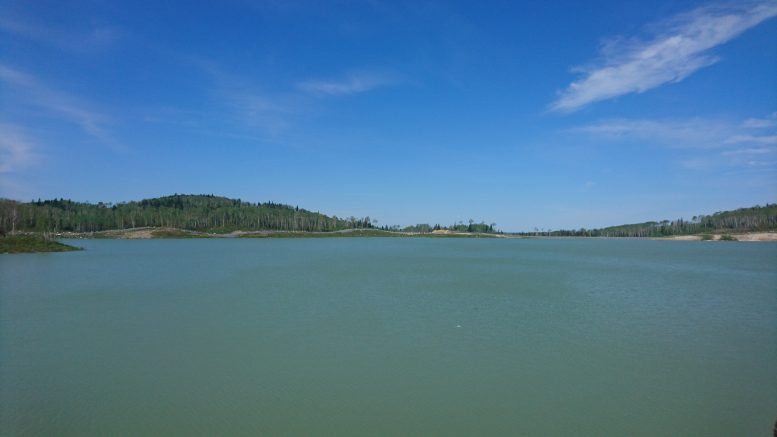
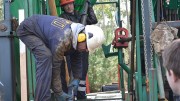
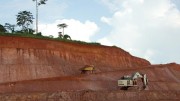
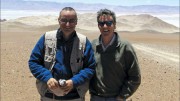
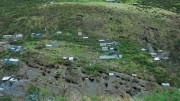
Be the first to comment on "Site visit: Alamos taps into Island Gold’s potential"